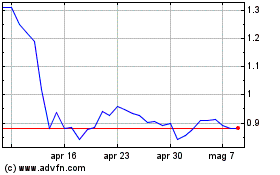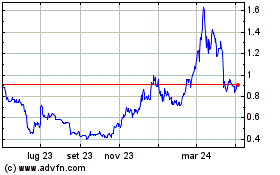

Several years back, many in the crypto community described
Bitcoin as a “safe-haven” asset. Fewer are calling it that
today.
A safe-haven asset maintains or increases in value in times of
economic stress. It can be a government bond, a currency like the
US dollar, a commodity like gold, or even a blue-chip
stock.
A spreading global tariff war set off by the United States, as
well as troubling economic reports, have sent equity markets
tumbling, and Bitcoin too — which wasn’t supposed to happen with a
“risk off” asset.
Bitcoin has suffered compared with gold, too. “While gold prices
are up +10%, Bitcoin is down -10% since January 1st,”
noted the
Kobeissi Letter on March 3. “Crypto is no longer viewed as a safe
haven play.” (Bitcoin dropped even further last week.)
But some market observers are saying that this wasn’t really
unexpected.

Bitcoin (white) and gold (yellow) price chart from Dec. 1 to
March 13. Source: Bitcoin
Counter Flow
Was Bitcoin ever a safe haven?
“I have never thought of BTC as a ‘safe haven,’” Paul Schatz,
founder and president of Heritage Capital, a financial advisory
firm, told Cointelegraph. “The magnitude of the moves in BTC are
just too great to be put in the haven category although I do
believe investors can and should have an allocation to the asset
class in general.”
“Bitcoin is still a speculative instrument for me, not a safe
haven,” Jochen Stanzl, Chief Market Analyst at CMC Markets
(Germany), told Cointelegraph. “A safe haven investment like gold
has an intrinsic value that will never be zero. Bitcoin can go down
80% in major corrections. I wouldn’t expect that from gold.”
Crypto, including Bitcoin, “has never been a ‘safe haven play’
in my opinion,” Buvaneshwaran Venugopal, assistant professor in the
department of finance at the University of Central Florida, told
Cointelegraph.
But things aren’t always as clear as they first appear,
especially when it comes to cryptocurrencies.
Related: Bitcoin dominance hits new highs, alts fade:
Research
One could argue that there are different kinds of safe havens:
one for geopolitical events like wars, pandemics, and economic
recessions, and another for strictly financial events like bank
collapses or a weakening dollar, for instance.
The perception of Bitcoin may be changing. Its inclusion in
exchange-traded funds issued by major asset managers like BlackRock
and Fidelity in 2024 widened its ownership base, but it may also
have changed its “narrative.”

It is now more widely seen as a speculative or “risk on” asset
like a technology stock.
“Bitcoin, and crypto as a whole, have become highly correlated
with risky assets and they often move inversely to safe-haven
assets, like gold,” Adam Kobeissi, editor-in-chief of the Kobeissi
Letter, told Cointelegraph.
There’s a lot of uncertainty where BTC is heading, he continued,
amid “more institutional involvement and leverage,” and there’s
also been a “narrative shift from Bitcoin being viewed as ‘digital
gold’ to a more speculative asset.”
One might think that its acceptance by traditional finance
giants like BlackRock and Fidelity would make Bitcoin’s future more
secure, which would boost the safe haven narrative -- but that’s
not necessarily the case, according to Venugopal:
“Big companies piling into BTC does not mean it has
become safer. In fact, it means BTC is becoming more like any other
asset that institutional investors tend to invest in.”
It will be more subject to the usual trading and draw-down
strategies that institutional investors use, Venugopal continued.
“If anything, BTC is now more correlated to risky assets in the
market.”
Bitcoin’s dual nature
Few deny that Bitcoin and other cryptocurrencies are still
subject to big price swings, further propelled recently by growing
retail adoption of crypto, particularly from the memecoin craze,
“one of the largest crypto-onboarding events in history,” Kobeissi
noted. But perhaps that is the wrong thing to focus on.
“Safe havens are always longer-term assets, which means that
short-term volatility is not a factor in that characteristic,”
Noelle Acheson, author of the Crypto is Macro Now newsletter, told
Cointelegraph.
The big question is whether BTC can hold its value longer-term
against fiat currencies, and it’s been able to do that. “The
numbers bear out its validity – on just about any four-year
timeframe, BTC has outperformed gold and US equities,” said
Acheson, adding:
“BTC has always had two key narratives: it is a
short-term risk asset, sensitive to liquidity expectations and
overall sentiment. It is also a longer-term store of value. It can
be both, as we are seeing.”
Another possibility is that Bitcoin could be a safe haven
against some happenings but not others.
“I see Bitcoin as a hedge against issues in TradFi,” like the
downturn that followed the collapse of the Silicon Valley Bank and
Signature Bank two years ago, and “US Treasury risks,” Geoff
Kendrick, global head of digital assets research at Standard
Chartered told Cointelegraph. But for some geopolitical events,
Bitcoin might still trade as a risk asset, he said.
Related: Is
altseason dead? Bitcoin ETFs rewrite crypto investment
playbook
Gold can serve as a hedge against geopolitical issues, like
trade wars, while both Bitcoin and gold are hedges against
inflation. “So both are useful hedges in a portfolio,” Kendrick
added.
Others, including Ark Investment’s Cathie Wood,
agree that
Bitcoin acted as a safe haven during the SVB and Signature bank
runs in March 2023. When SVB collapsed on March 10, 2023, Bitcoin’s
price was around $20,200, according to CoinGecko. It stood close to
$27,400 a week later, roughly 35% higher.

BTC price fell on March 10 before bouncing back a week
later. Source: CoinGecko
Schatz doesn’t see Bitcoin as a hedge against inflation. The
events of 2022, when FTX and other crypto firms collapsed and the
crypto winter began, “damages that thesis dramatically.”
Maybe it’s a hedge against the US dollar and Treasury bonds?
“That’s possible, but those scenarios are pretty dark to think
about,” Schatz added.
No time for over-reaction
Kobeissi agreed that short-term fluctuations in asset classes
“often have minimal relevance over a long-term time period.” Many
of Bitcoin’s fundamentals remain positive despite the current
drawdown: a pro-crypto US government, the announcement of a US
Bitcoin Reserve, and a surge in crypto adoption.
The big question for market players is: “What is the next major
catalyst for the run to continue?” Kobeissi told Cointelegraph.
“This is why markets are pulling back and consolidating: it’s a
search for the next major catalyst.”
“Ever since macro investors started seeing BTC as a
high-volatility, liquidity-sensitive risk asset, it has behaved
like one,” added Acheson. Moreover, “it is almost always short-term
traders that set the last price, and if they’re rotating out of
risk assets, we will see BTC weakness.”
Markets are struggling in general. There’s “the specter of
renewed inflation and an economic slowdown weighing heavy on
expectations” that are also affecting Bitcoin’s price. Acheson
further noted:
“Given this outlook, and BTC’s dual nature of risk
asset and long-term safe haven, I’m surprised it’s not falling
further.”
Venugopal, for his part, says Bitcoin hasn’t been a short-term
hedge or safe haven since 2017. As for the long-term argument that
Bitcoin is digital gold because of its 21 million BTC supply cap,
that only works “if a large fraction of investors collectively
expect Bitcoin to increase in value over time,” and “this may or
may not be true.”
Magazine: Crypto fans are obsessed with longevity and
biohacking: Here’s why
...
Continue reading Trade war puts Bitcoin’s status as
safe-haven asset in doubt
The post
Trade war puts Bitcoin’s status as safe-haven asset
in doubt appeared first on
CoinTelegraph.
Grafico Azioni Flow (COIN:FLOWUSD)
Storico
Da Mar 2025 a Mar 2025

Grafico Azioni Flow (COIN:FLOWUSD)
Storico
Da Mar 2024 a Mar 2025
